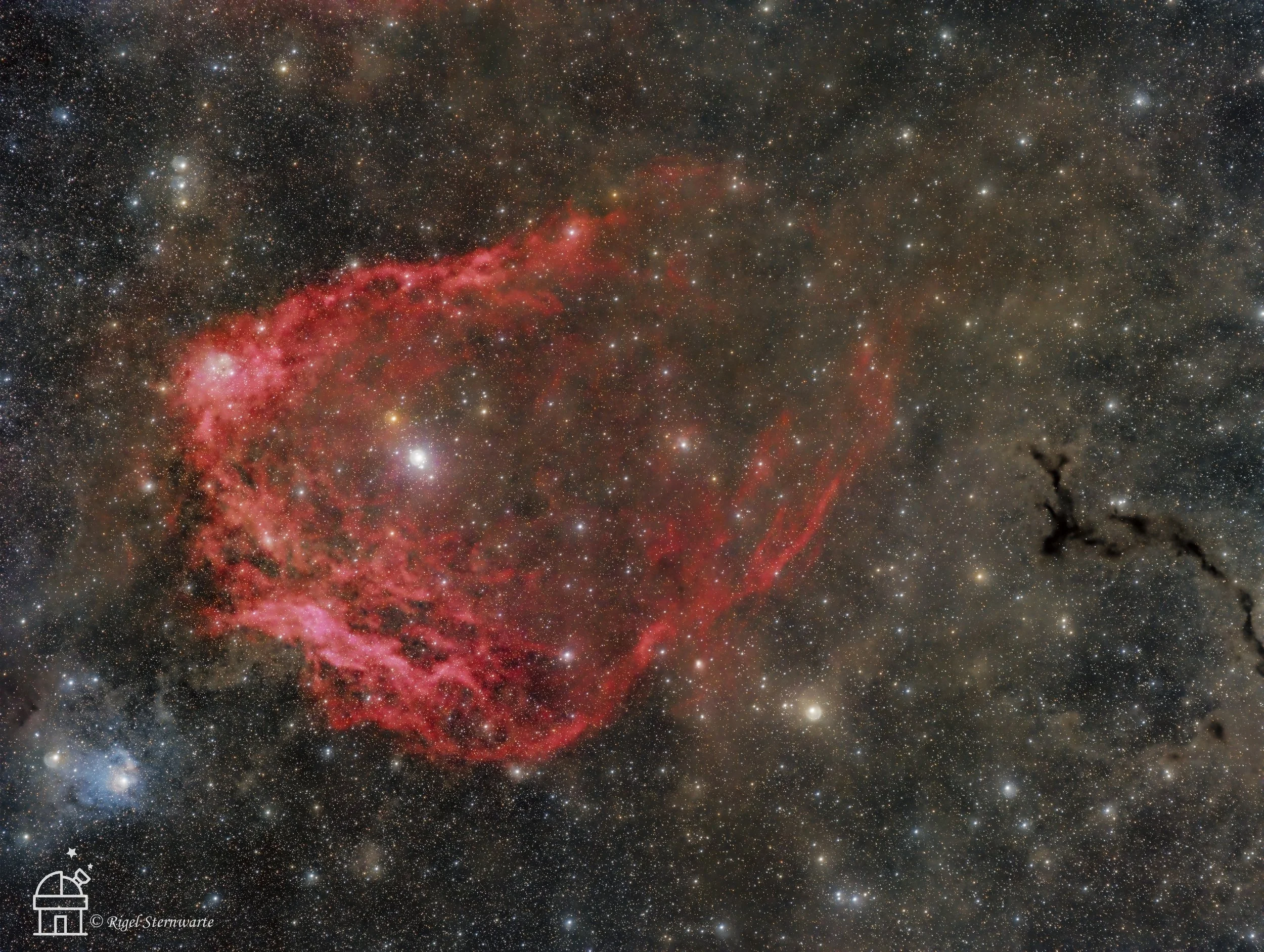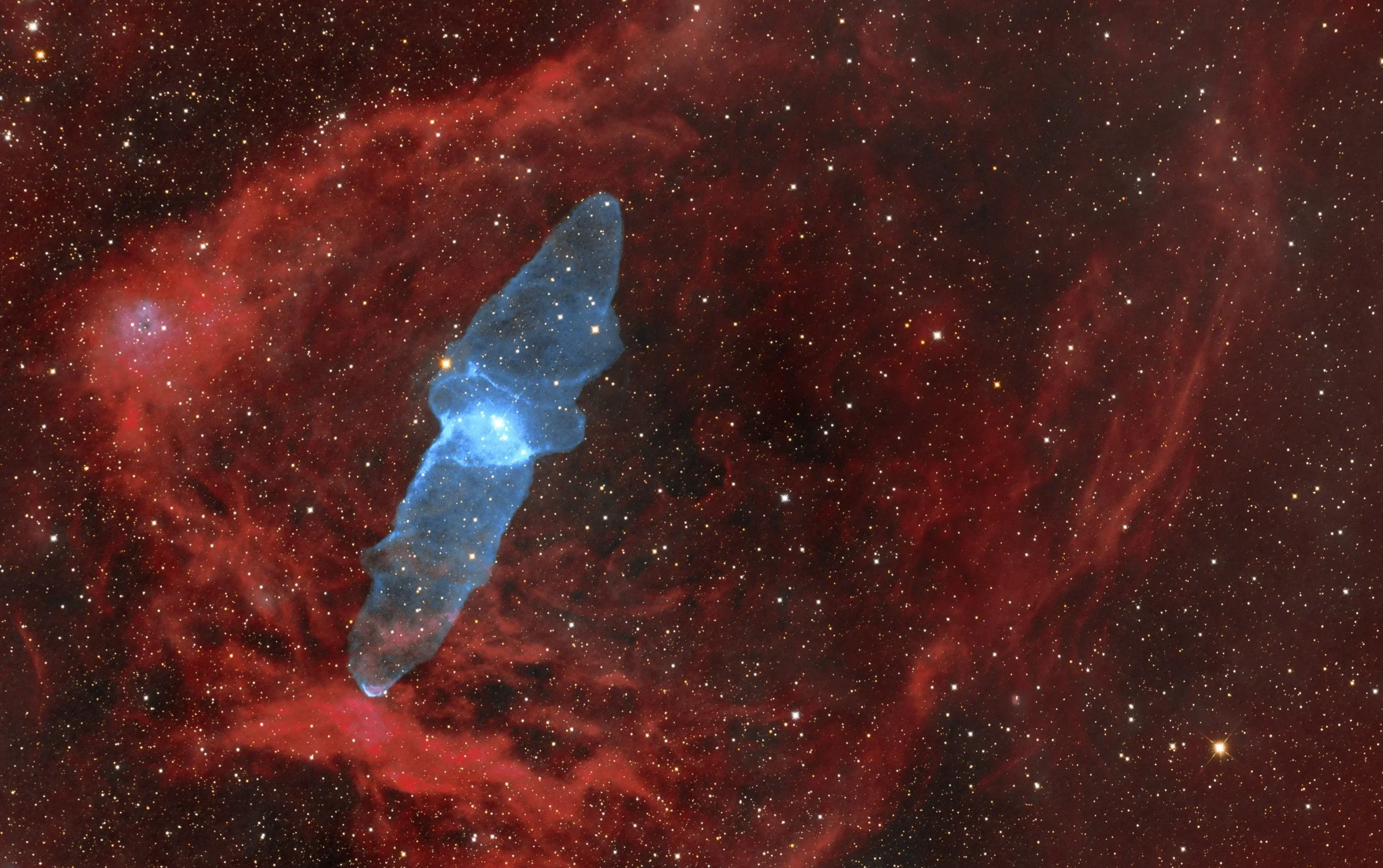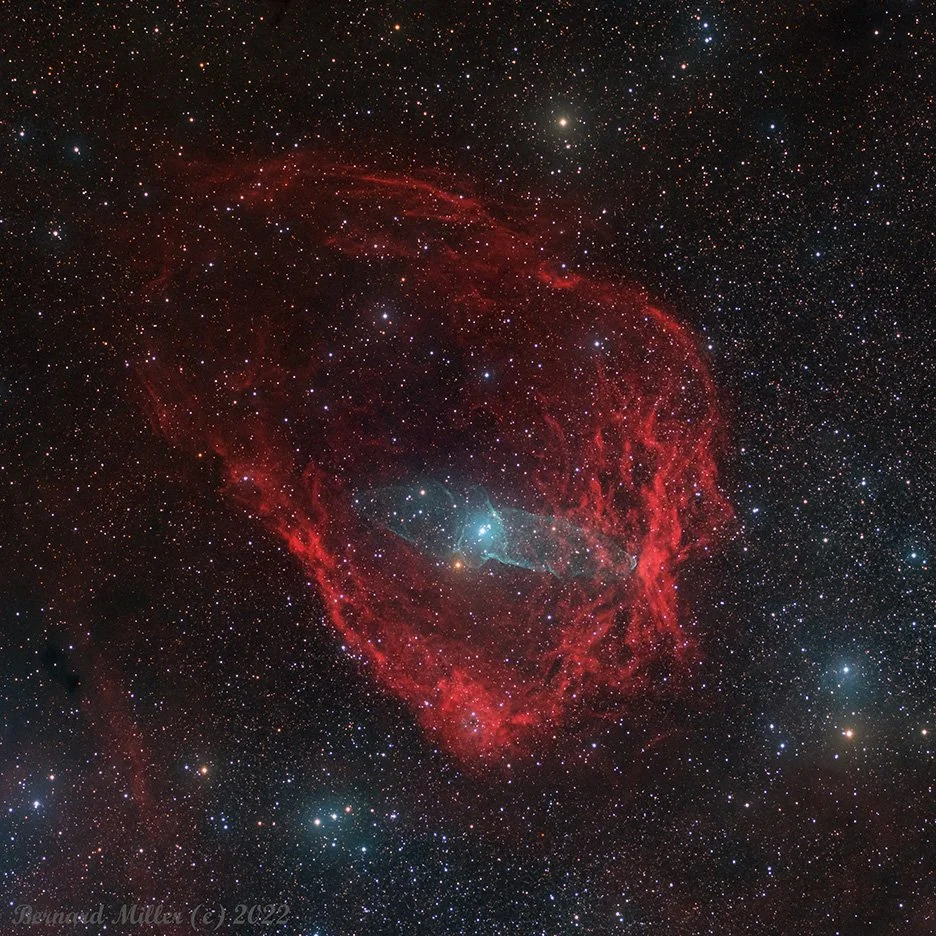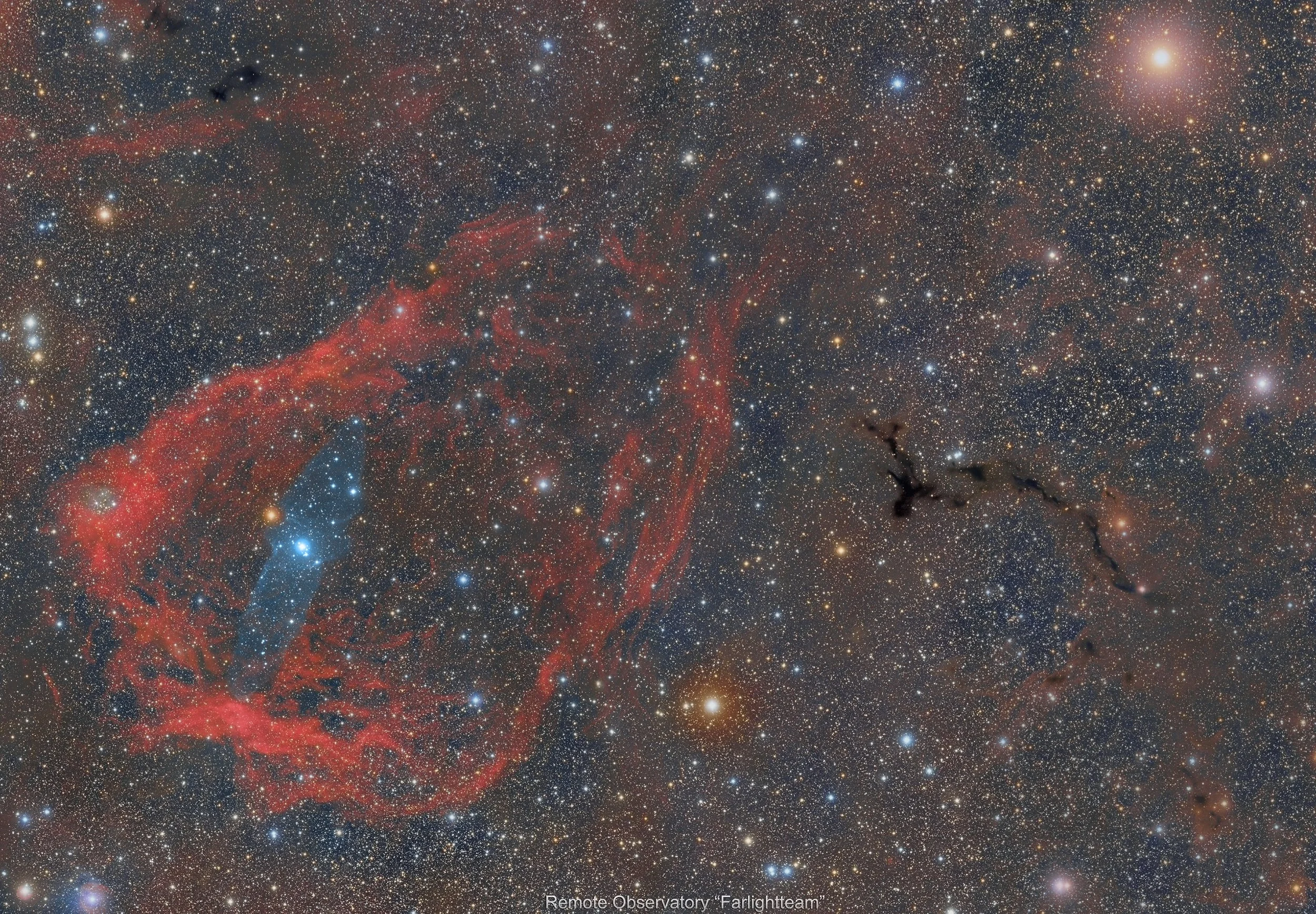
AAPOD2 Image Archives
SH2-129 LRGB
Sh2-129, also known as the Flying Bat Nebula, is an emission nebula located in the constellation of Cepheus. It derives its name from its resemblance to a flying bat with outstretched wings. Scientifically, Sh2-129 is a complex nebula featuring both emission and reflection components. Emission nebulae are formed by the ionization of gases by nearby stars, while reflection nebulae occur when dust particles scatter light from nearby stars. Sh2-129 is illuminated by the radiation from O-type stars, which are known for their high temperature and luminosity. Its intricate structure provides astronomers with an opportunity to study the interplay between stellar radiation and the surrounding interstellar medium. The examination of Sh2-129 contributes to our understanding of the mechanisms behind the shaping and evolution of such intricate cosmic formations.
Squid nebula OU4 - Flying Bat nebula SH2 129 - HOO version
Image Description and Details : Takahashi Espilon 130D RisingCam Mono & Color SkyWatcher EQ6-Pro H : 36 x 600s O: 139 x 600s RVB: 40 x 180s intégration: 31h
Copyright: Thierry BOUFFLET
The Flying Bat and Squid Nebulae
Image Details:
Location: Oria, Almeria, Spain
Telescope: Takahashi FSQ-106EDX4
Camera: FLI PL16803
Mount: Paramount MX+
Ha: 10x10 minutes (binned 1x1)
OIII: 80x10 minutes (binned 1x1)
RGB: 8x10 minutes each (binned 1x1)
Copyright 2022 Bernard Miller
Sh2-129 / OU4 / Barnard 150
Image Description and Details :
This image has been made from 343 hours of exposure through broadband (LRGB) and narrowband (H-alpha & OIII) filters, composed as an 8-panel mosaic. The result covers an area of approximately 3.50° x 5.10° at 2.09 arc''/pixel resolution. Placed on the surroundings of the constellation Cepheus, this area is rich in several DSOs: We can see Sh2-129, also known as the Flying Bat Nebula, a large and faint HII region showed here in its characteristic H-alpha deep red line.
Superposed to Sh2-129 we see the even fainter Ou4 nebula, colloquially the Giant Squid Nebula, discovered in 2011 by Nicolas Outters, a French amateur astronomer. At first identified as a planetary nebula emitting in the OIII blue-green doublet, it would be in fact the largest in apparent size yet identified, extending over one degree (Acker et al. 2012 - arXiv:1206.2477). However, Corradi et al. (2014 - arXiv:1407.4617) describe Ou4 as the result of a bipolar outflow emanating from a massive component of HR 8119, a triple system located 2,300 light-years away, thus about as far as Sh2-129. If confirmed, this would make it a truly perplexing object.
On the right side of this image appears Barnard 150, or Seahorse Nebula, a dark nebula distant 1,500 light-years, composed by three dense star forming cores, part of an elongated molecular cloud complex. Finally, close to the lower-left end we have identified HD 203025, a Be type star surrounded by a diffuse red nebulosity, captured here through the H-alpha filter. It was catalogued according to its colour and morphology as an IR centred nebula by Bodensteiner et al. (2018 - arXiv:1806.01294), resulting from a massive star member of an interacting binary system.
Technical data:
Telescope: Takahashi FSQ106 ED 530mm f/5
CCDs: QSI683 wsg8
Filters: Baader Planetarium -LRGB Ha OIII
Mount: 10Micron GM1000 HPS
Imaging Software: Voyager
Processing Software: Astropixel, Adobe PS, PixInsight
Imaging Data:
8-panel mosaic captured through July 2021 to December 2021
RGB: 170 x 600” (each). Total 84 hours.
Luminance: 280 x 900”. Total 70 hours.
Ha: 316 x 1200”. Total 106 hours.
OIII: 165 x 1800”. Total 83 hours.
Total Project : 343 hours
Copyright: Remote Observatory "FarLightTeam"
Team: José Esteban, Jesús M. Vargas, Bittor Zabalegui, Marc Valero.
Sh2-129, Outters 4 and VdB140
Image Description and Details :
This is my first +20h long exposure during my first year of astrophotography. 270*300s of exposures in HA and OIII.
Equipment used: Nikon 200mm f2 lens, Chroma 3nm Ha+OIII filters, Asi1600mm camera and NEQ6 mount.
Location: Finland.
Copyright: Jarkko Järvinen
A Flying Bat (Sh2-129)
A Flying Bat (Sh2-129) with a Squid (Ou4) Inside?
I have been wanting to try this deep sky object for two years. It is quit interesting two objects for the prices of one. In reality I only have a portion of Sh2-129, the Flying Bat Nebula, which is a huge region of hydrogen gas represented by the red color captured with the Hydrogen gas filter (Ha). Located in Cepheus approximately 2,300 light-years away, Sh2-129 is a faint emission nebula and has been known about since at least the 1950's as a neighbor to IC 1396, the Elephant Trunk Nebula. I must admit, even after looking at widefield images of the Sh2-129, I see no resemblance to a Flying Bat. The Squid on the other hand does resemble a squid with it tentacles rapped up. The Squid Nebula (Ou4) is a relatively new discovery from 2011 by French astro-imager Nicolas Outters. It consists doubly ionized oxygen which gives it the green-blue color in contrast to the hydrogen. It may seem odd that this was not found until 2011 but there is a really good reason, it is really dim. I was taking 5-minute subs and while there was some nebulosity in the Ha region, there was nothing in OIII, not even a hint. If you are the type that likes to complete an object in one night, then this would not be a good choice.
Originally the Ou4 was thought to be a Planetary Nebula unrelated to Sh2-129, however, recent studies suggest it is within Sh2-129 and is bipolar outflow from a triple star system. The bright blue star in the center is the believed to be the source.
I wanted to get at least 15-hours and was able to get this done quicker than I anticipated due to unexpected clear weather. It worked out really well as we had a succession of clear nights when I was painting my garage floor anyway so conveniently left everything set up and just put a cover over it. This was one of the hardest things I have processed due the conflicting things going on. The Ha data was really strong and came out very well with hardly any processing. Not surprisingly, the OIII was very difficult to bring out and a lot of time was spent on it. StarNet was used to make separate starless Ha and OIII images which were combined to make a starless HOO image. The last part of the process was merging the RGB stars with the HOO starless image. This turned out be more difficult as the method I normally use for combining RGB stars with narrowband images didn't work well with the starless image so I used alternative method in PS described by Trevor Jones.
Camera: ZWO ASI1600MM-Pro
Telescope: Astro-Tech AT115EDT 115mm Refractor Telescope
Focal Reducer: AstroTech Field Flatterner/Focal Reducer
Mount: Orion Atlas Pro
Filter Wheel: ZWO EFW 8 x 1.25"
Filter: ZWO Ha, OIII, R, G, B
Focuser: ZWO EAF
Autoguiding: ASI120 Mini attached to an Agena 50mm Guide Scope/ZWO 60mm Guidescope
Exposure: Ha 150 x 300s, OIII 165 x 300s, R 45 x 60s, G 29 x 60s, B 29 x 60s
Processing: APT, NINA, PixInsight, Photoshop.
Copyright: Kurt Zeppetello






